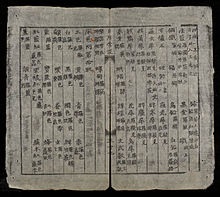|
|
| |
|
|
| |
|
|
|
|
| |
 |
| In the bilingual
dictionary Nhật dụng thường đàm (1851), Chinese
characters (chữ Nho) are explained in chữ Nôm. |
Vietnamese
Vietnamese (Tiếng Việt) is the official language of
Vietnam. Like many other languages in Asia, Vietnamese
is a tonal language
Influences
Vietnamese has been strongly influenced by Chinese
languages. It has a shared history with other languages
such as Khmer. It now uses a Latin alphabet that is
based on the French alphabet but was written based on
Chinese characters, called Chữ Nôm. Few people know Chữ
Nôm today.
Most Chinese speakers who live in Vietnam now use
regular Chinese script for calligraphy, but some
traditional calligraphy artists can still be found. For
example, Hồ Chí Minh City (sometimes still called Sài
Gòn) has a district that is famous for its popular
Chinatown.
Vietnamese adds new words when they are needed,
especially in the professions of engineering, science,
and academics. Also there has been an increase in media
use. Some social words from the media are now accepted
as common. |
|
Spoken language
The spoken language of Vietnam changes in each province.
The greater the distance between provinces, the stronger
the difference. There some diffference between the
Hanoian and the Mekong is called a dialects. The
national education for all of Vietnam now usesthe
Hanoian dialect, but each ethnic tribe may still use a
different dialect, language, or vocabulary.
Computers
There are speaking programs that use Vietnamese. A
computer add-on for the Firefox web browser, Vietnamese
TTS (Text to Speech), can read text with the 'Vietnamization
needs.
Audio libraries are available to reproduce Vietnamese.
Google translate uses a TTS reader and sound library to
read Vietnamese in simple sentences. Portable electronic
translators are also very popular. Kim Tu Dien makes the
most common portable dictionary for the Vietnamese
market. |
|
Written language
Alphabet
The Vietnamese alphabet (In Vietnamese: "Chữ Quốc Ngữ",
means "The National Scripts").
Diphthong
The combination of two vowels makes a diphthong. The
dipthongs used in the Vietnamese language have some
rules when used. For example, one rule states that the
singular tone for both letters must be placed.
Triphthongs
There are more triphthongs in Vietnamese than English,
such as 'uye'.
Vietnamese syllables
The syllables refers to the Chinese use of two
characters as syllables. Vietnamese also uses one
syllable as a word.Like in English, people can say just
'go'. For more emphasis, it could be said twice in
Vietnamese. That is common in Asia. n languages. Some
Australian Aboriginal languages do the same thing. So,
'go - go' (Vietnamese: đi đi) means "go now" but with
emphasis. However, 'go' is also common in Vietnamese.
Many single syllables are used in Vietnamese. They can
form sentences without pairing with other syllables as
they do in Chinese. Readers (and speakers) still notice
that many syllables, in most sentences, are paired.
Vietnamization (Make it
sounds like "Vietnamese")
Many words from around the world were needed in
Vietnamese. Sushi is a common word used by most
languages. When a word is vietnamized, it is changed to
sound Vietnamese. China uses the same idea: Ao-da-li-ya
in Pinyin means Australia.
The first rule for vietnamization is that Vietnamese
word or syllables are not normally broken by a
consonant: (Việt Nam). An example of how to break a
foreign word into two syllables is mô tô, one of the
words for "motorbike", is a vietnamized version of
'motor' and 'auto' (ô tô). However, the rule has
exceptions: lôgic.
When introducing a common foreign word, people
vietnamize the word in at least one spoken demonstration
for Vietnamese listeners.
This rule should explain a problem with the foreign use
of the family name Nguyễn. It is not New Yen since y is
not a consonant in Vietnamese. The y is pronounced as a
vowel as in English many and penny.
The second (softer) rule for vietnamization is that the
sound of each syllable must be made a little closer to
Viet sounds. Tone marks for vowel letters are added:
lôgic is an alteration of logic and would be need for a
few subjects.
Exceptions
Any word can be an exception to vietnamization. Names
like Barack Obama or Bill Clinton might be attempted by
Vietnamese-speakers. In writing, these foreign names
will mostly stay together. Names like David are easy for
the Vietnamese to say and so they have become very
popular in English writing. |
|
Grammar
Exclamations
Exclamations are very popular in Vietnamese. People can
use exclamations as an introduction to things said.
People can also comment with a quick exclamation after
they say something. The exclamation may express a
feeling or just an expression.
Conjunctions
Conjunctions are used in Vietnamese. |
|
|
 Kiddle: Vietnamese Kiddle: Vietnamese
Wikipedia: Vietnamese |
|
|
|
|
|
|
|
|
|
|
|
|
|
|
|
|
Search Fun Easy English |
|
|
|
|
|
|
|
|
|
|
|
|
|
|
|
About
Contact
Copyright
Resources
Site Map |